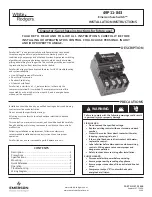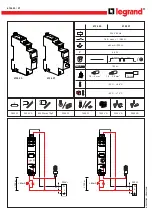
7
41-181.2K
current through the trip circuit to close the contacts of
the ICS. This value of current should be not greater
than the particular ICS tap setting being used. The
operation indicator target should drop freely.
The contact gap should be approximately .047”
between the bridging moving contact and the station-
ary contacts. The bridging moving contact should
touch the stationary contacts simultaneously.
7.1.3.2.
AC Indicating Contactor Switch (ACS)
Close the main relay contacts and pass sufficient ac
current through the trip circuit to close the contacts of
the ACS. This value of current should be not greater
than the particular ACS rated operating current being
used. The operation indicator target should drop
freely.
The contact gap should be approximately 3/32”
between the bridging contact and the adjustable sta-
tionary contacts. The bridging moving should touch
both stationary contacts simultaneously.
7.2. ROUTINE MAINTENANCE
All relays should be inspected periodically and the
time of operation should be checked at least once
every year or at such other time intervals as may be
dictated by experience to be suitable to the particular
application. Phantom loads should not be used in
testing induction-type relays because of the resulting
distorted current wave form which produces an error
in timing.
All contacts should be periodically cleaned. A contact
burnisher style #182A836H01 is recommended for
this purpose. The use of abrasive material for clean-
ing contacts is not recommended, because of the
danger of embedding small particles in the face of
the soft silver and thus impairing the contact.
8.0
CALIBRATION
Us the following procedure for calibrating the relay if
the relay has been taken apart for repairs or the
adjustments disturbed. This procedure should not be
used until it is apparent that the relay is not in proper
working order. (See “Acceptance Check”).
8.1. MAIN UNITS
For all electrical checks refer to test diagram figure 5.
For tapped CM, put tap screw in one amp tap setting.
1.
Balance Setting
a)
Mechanical balance - adjust spiral spring
until moving contact is located substantially
in the center of the scale plate.
b)
Electrical Balance
1.
Apply two amperes on front and rear
electromagnets and adjust resistor at
rear of specific unit being tested such
that the moving contact is in balance,
i.e., moving contact is aligned per part
“a” above.
2.
Apply twenty amperes on front and rear
electromagnets for approximately two
seconds and note that the moving con-
tact does not deviate from the balanced
condition more than approximately 1/4
inch.
For CM relays with adjustable magnetic plugs, only
the right-hand plug may be adjusted. At the factory,
the right-hand plug is adjusted to help obtain a bal-
anced condition of the contact at 20 amperes. The
moving contact is again checked at 2 amperes. Little
adjustment, if any, is expected to be necessary in the
field.
2.
Minimum Trip Setting
The front electromagnet energized alone should
produce a disc rotation to the left while the rear
electromagnet energized alone should produce a
disc rotation to the right.
a)
Apply one ampere to front electromagnet
and adjust left stationary contact until it just
makes with the moving contact. This setting
should correspond with the marking on scale
plate.
b)
Apply one ampere to rear electromagnet and
adjust right stationary contact until it just
makes with the moving contact. This setting
should correspond with marking on scale
plate.
3.
Operating Curve
Apply six amperes to front electromagnet and
vary current flowing through rear electromagnet.
a)
The moving contact should make with the






























